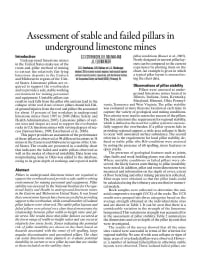Mining Publication: Assessment of Stable and Failed Pillars in Underground Limestone Mines
Original creation date: November 2008
Authors: GS Esterhuizen, DR Dolinar, JL Ellenberger
Pillars in underground limestone mines are required to support the overburden and provide a safe, stable working environment for mining personnel and equipment. Pillar stability was assessed by the National Institute for Occupational Safety and Health in underground limestone mines in the Eastern and Midwestern United States. It was found that current mine layouts have been successful in providing support to the overburden, while a small number of isolated pillar failures were observed. The stable pillar layouts and failed pillars were plotted on a chart that demonstrates the relationship between pillar width-to-height ratio and pillar stress. The results show that pillar failures occurred at the lower range of width-to-height ratios and can occur at relatively low stress levels. Zones indicating the potential risk of pillar instability are shown on the chart, based on hazards associated with the onset of rib spalling, large angular discontinuities and unconfined pillars. The chart can assist limestone mine planners to evaluate potential instability in current or new pillar layouts that are similar to those included on the stability chart.

- Analysis of Pillar Design Practices and Techniques for U.S. Limestone Mines
- The Effects of Roof and Floor Interface Slip on Coal Pillar Behavior
- Evaluation of the Effects of Length on Strength of Slender Pillars in Limestone Mines Using Numerical Modeling
- The Forgotten Denominator: Pillar Loading
- Observations and Evaluation of Floor Benching Effects on Pillar Stability in U.S. Limestone Mines
- Pillar Design and Strategies for Retreat Mining
- Pillar Design Issues for Underground Stone Mines
- Pillar Stability Issues Based on a Survey of Pillar Performance in Underground Limestone Mines
- Reducing the Risk of Ground Falls During Pillar Recovery
- The Unpredictable Life Cycle of a Coal Pillar